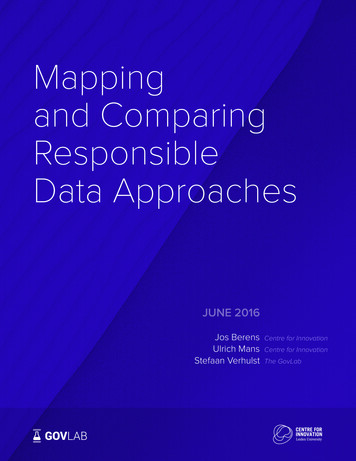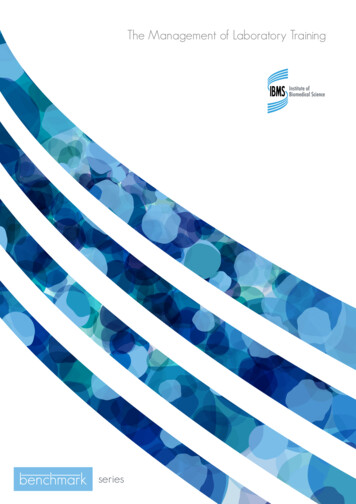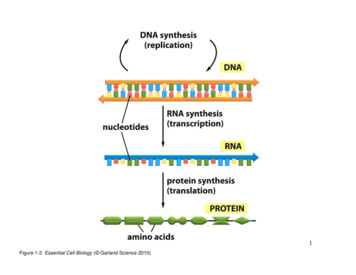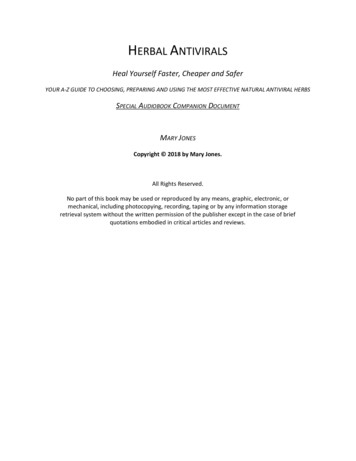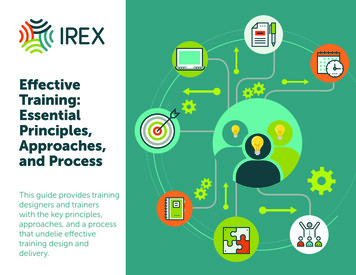
Transcription
nd ProcessThis guide provides trainingdesigners and trainerswith the key principles,approaches, and a processthat undelie effectivetraining design anddelivery.1
Key Training PrinciplesIREX’s training approach is characterized by six key principles – learner-centered, inclusion sensitive, actionable, experiential, active, measurable.These principles underlie training design and delivery.1Learner-CenteredA learner-centered training is an environment that pays careful attention to the knowledge, skills, attitudes, andbeliefs that participants individually bring to the space. Training esign and delivery starts with the consideration of theparticipant’s needs (National Research Council. 2000). This starts with the consideration of the participant’s context, knowledge and abilities – the Training Needs Assessment - whichinforms the design and delivery process as well as the approach to evaluation. From the culture of a participant to their race, gender,skills, and ability, trainings place emphasis on participants to ensure that the outcomes are responsive to their needs and realities.Acknowledging and respecting participant’s prior experiences and understandings helps build a bridge to new learning.2Inclusion SensitiveInclusion sensitive trainings acknowledge that diverse participants bring different experiences and perspectives toa training that can enrich the training experience for all. Such trainings strive to overcome patterns of exclusion based onactual or perceived connection to a social identity group that may affect access to training and/or learning dynamics during andafter a training. Differentiated approaches to training design and delivery ensure inclusion along locally relevant dimensions, from selectionprocesses to evaluation questions. IREX follows inclusion sensitivity principles that build trust and safety among diverse participants,fostering conditions for all participants to contribute and engage in all training activities.3ActionableActionable trainings focus on knowledge, skills, and attitudes that have a practical utility and will help participantsmake an impact. Assessing the needs of participants before design allows for training content that is directly linked to realisticactions that participants can do post-training. Learning objectives are fulfilled via actionable knowledge, skills, and attitudes that can be assessed.This enables participants todemonstrate desired competencies within trainings and apply the newly acquired learning after the training.3
4ExperientialExperiential learning is “learning by doing.” Experiential Learning Theory (ELT) is a holistic, cyclical process that emphasizesthat effective learning occurs when direct experience is tied to personal reflection, opportunities to make relevant connections tothe experience, and the ability to demonstrate the appropriate use of the knowledge or skill. Experiential trainings start with an analysis of participants’ needs then identify the appropriate activities for the training audienceand content. Experiential activities can range from activities that are conducted within the training space as well as those thatparticipants can do outside of the training space. Guidance on experiential learning activities is provided in Part 2: The IREX TrainingManual.5ActiveA form of experiential learning, active training enables a participant to engage with training content in an interactivemanner. What distinguishes active training is that it extends beyond “learning by doing” and uses formal training componentsto shape and support a participant’s learning processes. Activities are designed so that the participants acquire knowledge, skills,and attitudes rather than simply receiving them. Several activities allow for an active training environment, including role-playing, pairing participants for activities, and movementexercises. These elements, when intentionally and appropriately used in trainings result in increased participation, enlivenedlearning, deepened retention, and meaningful application.6Measurable veMeasurable trainings use learning objectives to develop appropriate evaluation plans and techniques that help extractlearning which can be applied to training design and delivery. In the design process, the careful development of learningobjectives that identify the knowledge, skills, or attitudes that will be gained by participants, allow for clarity in the measurementof a training’s success. Trainings are designed to lead to the impact that programs aim to make. The changes that result from IREX’s trainings are measuredto evaluate and learn from each training experience. Formative and summative assessments help the organization strengthen itstrainings to be effective at providing skills that lead to positive impact for participants worldwide.4
2. Training Design and Delivery at-a-GlanceIREX’s training design and delivery process involves key phases that result in a comprehensive, well-developed training program. This processinvolves reflecting and applying learning that is derived from the evaluation of a training. Learning from formative and summative evaluationsshould be applied to the framing; content; and delivery and evaluation phases of the training process.BeforeTraining DesignTraining Needs AssessmentYouth TrainingTraining Design:FramingApply Youth LearningPrinciples and PYDSelectPedagogyDigital or BlendedDelivery?Training Design:ContentApply LearningApply InclusionSensitive PrinciplesSelect DeliveryMethodAdult TrainingApply AdultLearning PrinciplesSelectActivitiesDesign ActivitiesApply LearningDesign EvaluationDevelop or RepurposeExisting TechnologyDevelop DigitalContentTrainingDelivery &EvaluationLearning ObjectivesDevelop MaterialsPilotDeliver TrainingEvaluate Training5
3. Training Youth and AdultsIREX trainings target both youth and adults. These audiences are distinct in the way that theylearn. This is because at different stages in life, brain development levels and life experiencesfactor into what is considered as effective learning. This section is divided into youth learning andadult learning and provides the principles that enable the best learning for both audiences. It isimportant to distinguish learning and training. Learning is the process of obtaining increasedknowledge, skills, or attitudes. It is focused on the training participant’s ability to acquire thecontent of the training.3.1 Youth LearningYouth trainings make up a significant portion of IREX trainings, therefore youth-friendlyenvironments that encourage positive development and use effective learning principles areimportant. Trainings that provide youth with the tools and abilities to learn, engage, and applytheir skills meaningfully, contribute to productive citizenship.1Research shows that from age 14 to 18 and beyond, young people gain the ability to acquireadvanced forms of reasoning and executive functioning. This is characterized by the abilityto differentiate evidence from fact or analyze experiences. During this time, youth begin tounderstand and become more aware of how emotions disrupt attention and how they caninhibit unwanted thoughts. They also become more aware of the communities around them andthe larger world and question their role and relationship in it. In addition, middle adolescentsdevelop the ability to reason for planned action (Halpern, Heckman, & Larson, 2013).Early Adolescent Learning(Ages 10 to 13)Early adolescents learning needsdiffer from older adolescents. When trainingearly adolescents, apply these principles indesign and delivery:1. Early adolescent learning ischaracterized as engaging in strong,intense interests, that are often shortlived.2. Early adolescents prefer interactionswith their peers3. Early adolescents prefer active topassive learning. Their brain growth isenhanced and strengthened throughpractice and exercise.From Brain Development for Adolescents,NEAThis period in a young person’s life requires learning approaches that are tailored to their needs.As new cognitive and social capacities are developed, there are effective learning principles thatshould be used in training.1IREX defines youth as people between the ages of 10 and 29 (in line with USAID’s Youth in Development policy), unless otherwise noted for a specific training orcontext.6
9 Youth Learning PrinciplesPrincipleIn Practice1Youth gain mastery through in depth and immersive learning.Provide opportunities for practice with new tasks and problems, forcontinued use of new knowledge and skills.2Youth learn best when less experienced learners can workalongside more experienced peers or skilled adults.Provide collaboration opportunities - brainstorm possibilities, poolknowledge and insights, conduct collective analyses, critique each other,and draw energy from a common goal.3Youth thrive when working on challenges because they canaddress difficult but accessible problems.Provide lessons and activities that require problem solving and criticalthinking.4Youth are intrinsically motivated to learn at deeper levels throughpersonally meaningful experiences that connect to peers oradults.Provide opportunities to learn more about a topic, build competence init, and connect with others who share on the topic.5Youth learn when information is presented as unfinishedproducts that leave room for their contributions.Provide opportunities for making learning experiences their own throughusing individual or group projects.6Youth desire to use, apply, make sense, and make connections towhat they learn.Allow work on tasks that have meaning and value to the themselves orothers7Youth find it valuable to recognize a range of feelings.The learning environment should be sensitive to the role of emotion inactivities.8Youth learn to use failure as an important part of the learningprocess when assessments are closely to learning.Share criteria used for assessment and ensure clear markers of progressand growth.9Youth learn when there are opportunities for them to experiencea range of adult roles.Include opportunities to engage with adults on diverse tasks and ensuresupport by a rich/multi-dimensional adult role (i.e. mentors).Adapted from How Youth Learn, 20137
Positive Youth Development in TrainingTo achieve positive outcomes for youth, IREX incorporates Positive Youth Development (PYD) in trainings. PYD compliments youth learningprinciples and is defined by USAID as an intentional, prosocial approach that engages youth within their communities, schools, organizations,peer groups, and families in a manner that is productive and constructive; recognizes, utilizes, and enhances young people’s strengths; andpromotes positive outcomes for young people by providing opportunities, fostering positive relationships, and furnishing the support neededto build on their leadership strengths (Positive Youth Development, 2017).3.2 Adult LearningTrainings with adult2 participants are common at IREX. The needs of adults in a training environment differs from the needs of youth. Therefore,it is important for training design and delivery to be informed by adult learning principles. For adults to learn and apply the content introduced intrainings, their learning needs must be prioritized.IREX’s adult learning principles are drawn from the work of Malcolm Knowles. It is not only important to know the principles, but to also apply themto training effectively.4 Adult Learning PrinciplesPrincipleIn Practice1Adults need to be involved in their own learning.Encourage participants to self-evaluate and assess their own learning andperformance. In addition, provide opportunities for participants to design theirindividual learning experience (i.e. through projects they choose and design).2Experience (including mistakes) provides the basis for thelearning activities.Provide opportunities for learners to reflect upon and share their existingknowledge and experience.3Adults are most interested in learning subjects that haveimmediate relevance and impact to their job or personal life.Make a connection between the learning content and each participant's longterm professional or personal goals.4Adult learning is problem-centered rather than contentoriented.Share examples and stories that relate the learning content to participant'scurrent challenges or ask participants to share their own examples.Adapted from Knowles, M. S. (1984). Andragogy in action: applying principles of adult learning. San Farancisco: Jossey-Bass.Note: Adult and youth learning have some overlaps, especially in the way older youth and adults learn. The principles for adults can be applied to youthlearning when deemed appropriate for the target audience in training design and/or delivery.2IREX defines adults as people above the age of 29, unless otherwise noted for a specific training or context.8
4. Inclusion Sensitivity Approaches in TrainingsIREX’s training audiences are diverse. They range from youth to adults who represent different geographic regions and ethnic groups, speak differentlanguages, belong to different faiths, and are different genders and sexual orientations, among other social and cultural identities. The immensediversity among participants requires that all trainings are inclusion sensitive3 to ensure that every participant is able and empowered to equallyparticipate and contribute. Trust and safety are essential.Creating an inclusive environment starts in design, from the moment participant selection criteria and outreach strategies are conceptualized towhen a training begins. In some cases, where engagement with participants starts before the training event, setting the expectation for an inclusiveenvironment will involve many members of a program team. In all cases, training designers and trainers have an important role in promoting andmodeling inclusion while encouraging discussion and reflection during training events.Gender Sensitivity in Training ApproachA gender sensitive training explicitly addresses gender differences inexisting roles, knowledge, skills, attitudes and beliefs that affect accessto the training, receptivity to the topic, and opportunities to apply newknowledge and skills after the training. Such differences may be relatedto disposable income or time, availability to travel, literacy levels,educational attainment, public and private leadership roles, occupationaltrends, etc. It is important that training design, delivery, and evaluationconsider and respond to gender-specific needs and priorities that affectproductive learning.Gender inequality is an obstacle to equitable and sustainabledevelopment around the world. Trainings globally should strive to gobeyond accommodating gender differences to transforming them in waysthat widen opportunities and reduce constraints.Sexuality Sensitivity in Training ApproachAn inclusive training environment recognizes and respects all individuals,regardless of sexual orientation. In many societies, people who do notconform to dominant societal norms around sexual orientation andgender identity or expression are marginalized. Trainings are inclusivespaces where the agency and dignity of all people are recognized andrespected.3In Practice: Create a “Brave Space” withmethods that increase the active participation ofboth women and menOften there is dissent regarding the extent to which biological sexdifferences align with socially constructed gender differences. Throughthoughtful content and trainer-facilitated discussions, participants canlearn to listen and respectfully question gender-related facts and opinionsin a “brave space” that may be uncomfortable at times, but is never unsafe.To address behavioral differences between men and women, participatorymethods such as using small groups or organizing separate women andmen’s groups can help both genders contribute effectively.In Practice: Incorporate positive representationsof LGBT peopleProvide positive representations of LGBT people to help create a tone ofacceptance and increase awareness of LGBT related issuesIREX defines adults as people above the age of 29, unless otherwise noted for a specific training or context.9
A broad acronym that is used for non-heterosexual people is LGBT or LGBTQ, which refers to people who identify as lesbian, gay, bisexual and/ortransgender. The “Q” refers to people who identify as “queer” and/or “questioning.” In this section and in Annex D, LGBT will be used as an umbrellaterm for this diverse group of individuals.Ability Sensitivity in Training ApproachEnsuring that trainings are accessible and responsive to the needs ofpeople with disabilities is central to trainings. People with disabilitiescan feel excluded in trainings if there are few or no opportunities for theiractive participation. From activity modifications to facility considerations,meeting the needs of participants who require accommodations allowstrainings to be more inclusive.In Practice: Pay attention to energy levelsAttention to energy levels of participants is necessary with any group,particularly for long sessions. Since some disabilities may affect energylevels due to reasons like medications or the effort needed for use ofassistive technology, check-ins with participants with disabilities can helpadjust sequencing and timing of activities, as needed.Culture Sensitivity in Training ApproachTraining diverse groups requires culture sensitive approaches that helpoptimize learning for multi-cultural groups. Awareness of socioculturalissues and effective approaches for design and delivery of trainings forculturally diverse participants is important. From considering the roleof language to delivering trainings informed by global perspectives(i.e. customs and beliefs), culture sensitive approaches contribute to atraining that embraces cultural difference by recognizing the role thatculture plays in the lives of participants in and outside of the learningenvironment.In Practice: Incorporate perspectives andmaterials from people of different backgroundsWhen designing and delivering a training, include diverse content thatreflects different cultures. Using a variety of cultural references tailored tothe context where a training is held helps participants connect with andunderstand the content.To be effective, a training must consider and acknowledge difference inculture, which may include race, ethnicity, values, and beliefs.10
IREX's training approach is characterized by six key principles - learner-centered, inclusion sensitive, actionable, experiential, active, measurable. These principles underlie training design and delivery. Learner-Centered A learner-centered training is an environment that pays careful attention to the knowledge, skills, attitudes, and


